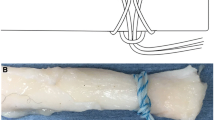Abstract
Our aim was to identify alternative suture materials that might provide superior knot performance and equivalent ease of manipulation by means of an in vitro experimental study. Although used widely for arthroscopic shoulder stabilisation, absorbable poly(p-dioxanone) (PDS) monofilament sutures can lead to dehiscence and clinical failure due to knot slippage and/or loop elongation at low applied loads. With the objective of identifying alternative suture materials that might provide superior knot performance and equivalent ease of manipulation, an in vitro experiment was undertaken in which both Duncan and Snyder knotted loops were tied from four different suture materials using an arthroscopic knot pusher (Surgeon’s 6th Finger) and a wooden practice box (Arthrex). Three monofilament sutures, made from polypropylene (PROLENE), poly(glycolidetrimethylenecarbonate-co-dioxanone) (Biosyn) and PDS, and one braided polyester suture (SURGIDAC) were tested. Ease of manipulation was evaluated by measuring the time required to tie the knots, and the knot performance was assessed in terms of loop elongation and loop holding capacity by performing cyclic fatigue testing of the loops while they were immersed in saline on an INSTRON mechanical tester. The PROLENE and SURGIDAC sutures showed improvements in loop elongation and loop holding capacity over PDS, with the Snyder knots being consistently superior to Duncan knots. BIOSYN gave no improvement over PDS. Difficulties were encountered in advancing half-hitch throws of the braided SURGIDAC suture down the cannula, which resulted in longer knotting times. In conclusion, both the polypropylene and polyester sutures gave superior knot performance to PDS, but only the polypropylene gave equivalent ease of manipulation. As a result there may be clinical advantages in replacing PDS with monofilament polypropylene or braided polyester sutures for certain arthroscopic procedures.

Similar content being viewed by others
References
Mishra DK, Cannon WD, Lucas DJ, Belzer JP (1997) Elongation of arthroscopic tied knots. Am J Sports Med 25:113–117
Chu CC (1983) Survey of clinically important wound closure biomaterials. In: Biocompatible polymers, metals, composites. Technomic, Lancaster, PA, pp 477–523
Loutzenheiser TD, Harryman DT, Yung SW, France MP, Sidles JA (1995) Optimizing arthroscopic knots. Arthroscopy 11:199–206
Burkhart SS, Wirth MA, Simonick M, Salem D, Lanctot D, Athanasiou K (1998) Technical note: loop security as a determinant of tissue fixation security. Arthroscopy 14:773–776
Batra EK, Franz DA, Towler MA, Rodeheaver GT, Thacker JG, Zimmer CA, Edlich RF (1992) Influence of emergency physician’s tying technique on knot security. J Emerg Med 10:309–316
James JD, Wu MM, Batra EK, Rodeheaver GT, Edlich RF (1992) Technical considerations in manual and instrument tying techniques. J Emerg Med 10:469–480
Magilligan DJ, DeWeese JA (1974) Knot security and synthetic suture materials. Am J Surg 127:355–358
Van-Rijssel EJ, Trimbos JB, Booster MH (1990) Mechanical performance of square knots and sliding knots in surgery: comparative study. Am J Obstet Gynecol 162:93–97
Fischer SP (1995) Arthroscopic knot-tying. In: Proceeding of Arthroscopy Association of North America annual meeting, pp 180–193
The United States Pharmacopeia (1995) The National Formulary, USP 23, NF 18. United States Pharmacopeial Convention, Inc., Rockville, MD
Author information
Authors and Affiliations
Corresponding author
Rights and permissions
About this article
Cite this article
Li, X., King, M. & MacDonald, P. Comparative study of knot performance and ease of manipulation of monofilament and braided sutures for arthroscopic applications. Knee Surg Sports Traumatol Arthrosc 12, 448–452 (2004). https://doi.org/10.1007/s00167-004-0503-y
Received:
Accepted:
Published:
Issue Date:
DOI: https://doi.org/10.1007/s00167-004-0503-y




